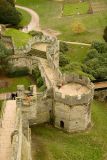Warwick Castle is of special relevance for Ricardians, as it is the birthplace of Richard III’s queen Anne Neville (on 11 June 1456).
Warwick Castle was begun by William I in 1068 in the motte-and-bailey type, using the cliff and river Avon on the one side as a natural defence, the other walls are protected by a dry moat. The castle’s most formidable defences are at the north-east end, where in the 14th century a central gatehouse tower and two other towers, Caesar’s and Guy’s Towers, were built.
The castle was part of the Beaumont and then the Beauchamp inheritance. Through Anne Beauchamp, the title Earl of Warwick and the Warwick estates had come to Richard Neville, who became the 16th Earl of Warwick and would later be known as the “Kingmaker”. They had two daughters, Isabel and Anne, but no sons. After Richard Earl of Warwick fell at the Battle of Barnet, the estates were divided between Anne Beauchamp’s two sons-in-law, Edward IV’s younger brothers George Duke of Clarence and Richard Duke of Gloucester. The earldom went to George as the husband of the older daughter. After the deaths of both Isabel (in 1476) and George (in 1478) their then three-year–old son Edward inherited the estates. Due to his minority it was in the custody of the crown [1].
 The Bear and Clarence Towers, Warwick Castle (Photograph taken by Andrew Griffith; obtained through Wikimedia Commons.)
The Bear and Clarence Towers, Warwick Castle (Photograph taken by Andrew Griffith; obtained through Wikimedia Commons.)
Richard Duke of Gloucester, alter Richard III, was the patron of many building schemes, among them extensive new works at Warwick Castle, although he visited the castle only once [2]. In 1480 it had become necessary to repair the old walls on the north-west side castle. Some of the walls were demolished and Richard started to build two octagonal artillery towers, the Bear Tower and the Clarence Tower (named after Richard’ brother, George Duke of Clarence), which also had their own well and baking ovens. However, due to Richard’s early death the towers were never finished and the small towers we see today are only the lower levels of the much higher towers which were envisaged. (You can find a diagram of the castle here.)
By the end of the 16th century the castle had fallen into disrepair. In the 17th century the castle was transformed into a country house [3].
All this will come alive during a one day workshop exploring the medieval history of Warwick on 8 November 2010. The study day is organised by Warwickshire County Council. The day covers four main areas:
1. The Origins and Growth of Early Medieval Warwick, where evidence that Warwick was actually founded on a minster of seventh century foundation will be investigated.
2. The Medieval Town of Warwick, covering the social, religious and economic history of the town from the 13th to the 16th century.
3. Beaumonts and Beauchamps: the Roots of Power
4. Warwick Castle, here the architectural development of the castle from 1068 to the end of the 16th century will be explored.
What a pity that we cannot just pop over to take part in such an interesting programme! You can find more information on the Study Day here.
Notes:
1. “The borough of Warwick”
2. Ross, p.143
3. “The borough of Warwick”
Bibliography:
“The borough of Warwick: The castle and castle estate in Warwick”, A History of the County of Warwick: Volume 8: The City of Coventry and Borough of Warwick (1969), pp. 452-475. Accessed 1 November 2010.
Charles Ross, Richard III. Yale English Monarchs, Yale University Press, 1999, Reprinted 2005. ISBN 0 300 07979-6 (pbk)
Tags: Castles, Nevilles, Richard III

Leave a reply